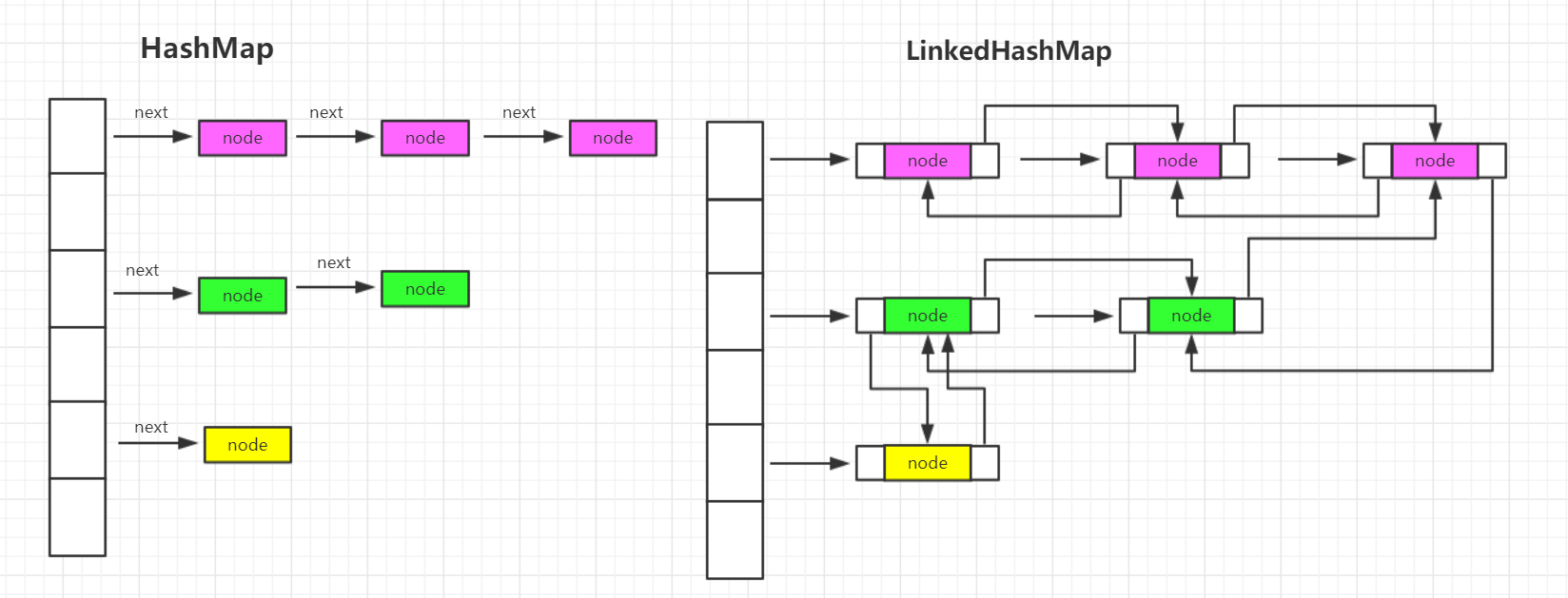jdk源码阅读笔记-LinkedHashMap
Map是Java collection framework 中重要的组成部分,特别是HashMap是在我们在日常的开发的过程中使用的最多的一个集合。但是遗憾的是,存放在HashMap中元素都是无序的,原因是我们在put或get数据的时候都是根据key的hash值来确定元素的位置。在具体的业务场景中,我们更多的希望对于HashMap集合能够进行顺序访问,好在 jdk 中已经给我们提供了一种解决方案,那就是LinkedHashMap。该类继承与HashMap,因此HashMap拥有的特性它都有,同时还具备其他的特性,比如实现了插入顺序排序和访问顺序排序,默认以插入顺序排序。同时也能够利用LinkedHashMap实现LRU算法。LinkedHashMap api很少,基本都是调用HashMap的方法,所以建议熟悉HashMap源码之后再来看这篇文章,我之前也写过【HashMap源码分析笔记】,大家可以点进去参考一下。
LRU算法: LRU是Least Recently Used的缩写,即最近最少使用,也就是说将热点数据放到最前面,冷门数据放到最后,当达到一定条件后会删除冷门数据,在一个缓存系统中经常会用到该算法。
一、LinkedHashMap与HashMap数据结构对比

从上图可以看到HashMap的数据结构位数组+单向链表,数据存放在链表的node节点上,每个node节点上都有一个指针指向下一个节点,每个数组index上的链表跟其他的index上面的链表是部相互链接的。LinkedHashMap在部破坏HashMap的结构基础之上,每个node节点都额外增加了两个指针,分别指向了前一个节点和下一个节点,所以在HashMap上所有的node节点形成了一条双向链表,每次添加往LinkedHashMap put数据的时候都将节点放在双向链表的最后位置,从而实现了插入顺序排序。在LinkedHashMap中,节点的定义如下:
/** * HashMap.Node subclass for normal LinkedHashMap entries. */ static class Entry<K,V> extends HashMap.Node<K,V> { Entry<K,V> before, after; Entry(int hash, K key, V value, Node<K,V> next) { super(hash, key, value, next); } }
节点继承与HashMap的 Node内部类,但是又额外添加了两个属性,before和after,分别指向前一个节点和后一个节点,形成一个双向链表。
二、LinkedHashMap类结构
public class LinkedHashMap<K,V> extends HashMap<K,V> implements Map<K,V> { ....... }
LinkedHashMap继承了HashMap,所以拥有HashMap的所有特性。
三、成员变量
/** * The head (eldest) of the doubly linked list. */ transient LinkedHashMap.Entry<K,V> head; /** * The tail (youngest) of the doubly linked list. */ transient LinkedHashMap.Entry<K,V> tail; /** * The iteration ordering method for this linked hash map: <tt>true</tt> * for access-order, <tt>false</tt> for insertion-order. * * @serial */ final boolean accessOrder;
LinkedHashMap在HashMap的基础之上添加了head、tail和accessOrder属性:
head:双向链表的表头
tail: 双向链表的表尾
accessOrder:排序的标志。默认为false,按插入顺序排序。可以通过构造方法设置为true,按访问顺序排序。
四、构造方法
/** * Constructs an empty insertion-ordered <tt>LinkedHashMap</tt> instance * with the specified initial capacity and load factor. * * @param initialCapacity the initial capacity * @param loadFactor the load factor * @throws IllegalArgumentException if the initial capacity is negative * or the load factor is nonpositive */ public LinkedHashMap(int initialCapacity, float loadFactor) { super(initialCapacity, loadFactor); accessOrder = false; } /** * Constructs an empty insertion-ordered <tt>LinkedHashMap</tt> instance * with the specified initial capacity and a default load factor (0.75). * * @param initialCapacity the initial capacity * @throws IllegalArgumentException if the initial capacity is negative */ public LinkedHashMap(int initialCapacity) { super(initialCapacity); accessOrder = false; } /** * Constructs an empty insertion-ordered <tt>LinkedHashMap</tt> instance * with the default initial capacity (16) and load factor (0.75). */ public LinkedHashMap() { super(); accessOrder = false; } /** * Constructs an insertion-ordered <tt>LinkedHashMap</tt> instance with * the same mappings as the specified map. The <tt>LinkedHashMap</tt> * instance is created with a default load factor (0.75) and an initial * capacity sufficient to hold the mappings in the specified map. * * @param m the map whose mappings are to be placed in this map * @throws NullPointerException if the specified map is null */ public LinkedHashMap(Map<? extends K, ? extends V> m) { super(); accessOrder = false; putMapEntries(m, false); } /** * Constructs an empty <tt>LinkedHashMap</tt> instance with the * specified initial capacity, load factor and ordering mode. * * @param initialCapacity the initial capacity * @param loadFactor the load factor * @param accessOrder the ordering mode - <tt>true</tt> for * access-order, <tt>false</tt> for insertion-order * @throws IllegalArgumentException if the initial capacity is negative * or the load factor is nonpositive */ public LinkedHashMap(int initialCapacity, float loadFactor, boolean accessOrder) { super(initialCapacity, loadFactor); this.accessOrder = accessOrder; }
5个构造方法都是直接调用父类HashMap的构造方法。
五、添加数据put(Object key,V value)
LinkedHashMap中并没有对HashMap进行复写,也就是说添加数据的时候其实就是调用的HashMap的put方法,那么它是怎么进行排序的呢?下面我们一起来看看HashMap中是怎么添加数据的吧。
public V put(K key, V value) { return putVal(hash(key), key, value, false, true);
}
final V putVal(int hash, K key, V value, boolean onlyIfAbsent, boolean evict) { Node<K,V>[] tab; Node<K,V> p; int n, i; if ((tab = table) == null || (n = tab.length) == 0) n = (tab = resize()).length; /** * 通过位与的方式来确定下标位置,判断当前下标位置是否为空,如果为空直接放入到该位置上 * 不为空则通过equals方法来寻找当前位置上面的元素,如果有相同的key,则将覆盖掉,如果没有则将node放置在对应 * 位置上面 */ if ((p = tab[i = (n - 1) & hash]) == null)//直接放到数组中 tab[i] = newNode(hash, key, value, null);//创建新节点 else {//当前位置不为空 Node<K,V> e; K k; if (p.hash == hash && ((k = p.key) == key || (key != null && key.equals(k))))//已存在相同的key的数据,将其覆盖 e = p; else if (p instanceof TreeNode)//当前位置是红黑树,将Node节点放到红黑树中 e = ((TreeNode<K,V>)p).putTreeVal(this, tab, hash, key, value);//创建新树节点 else {//为链表的情况 for (int binCount = 0; ; ++binCount) { if ((e = p.next) == null) { p.next = newNode(hash, key, value, null);//创建新节点 //链表的长度超过转换红黑数的阈值,则将该链表转成红黑树 if (binCount >= TREEIFY_THRESHOLD - 1) // -1 for 1st treeifyBin(tab, hash); break; } if (e.hash == hash && ((k = e.key) == key || (key != null && key.equals(k))))//覆盖相同key的node break; p = e; } }
//map中已经存在了相同的key,将原来的数据替换掉 if (e != null) { // existing mapping for key V oldValue = e.value; if (!onlyIfAbsent || oldValue == null) e.value = value; afterNodeAccess(e);//替换数据被视为更新数据,所以调用访问排序方法。 return oldValue; } } ++modCount;//快速失败机制 if (++size > threshold)//每次插入数据都要判断一下当前存储的数据是否需要扩容 resize(); afterNodeInsertion(evict);//插入数据后进行插入排序 return null; }
HashMap 插入数据的核心方法为 putVal方法,每次插入数据都调用newNode方法,这个方法LinkedHashMap 中已经重写了:
Node<K,V> newNode(int hash, K key, V value, Node<K,V> e) { LinkedHashMap.Entry<K,V> p = new LinkedHashMap.Entry<K,V>(hash, key, value, e); linkNodeLast(p); return p; }
第一:因为已经重写了父类的newNode方法,所以在插入数据时创建新节点实际是调用了LinkedHashMap的newNode方法,该方法中每次创建新节点都想LinkedHashMap自身维护的双向链表的尾部添加一个当前新创节点,我们继续看看linkNodeLast方法:
private void linkNodeLast(LinkedHashMap.Entry<K,V> p) { LinkedHashMap.Entry<K,V> last = tail; tail = p; if (last == null) head = p; else { p.before = last; last.after = p; } }
这个方法很简单,如果链表为空则将新节点设置为头部和尾部,否则将新节点放到链表的最后,将新节点的前指针指向原尾部的节点,原尾部节点的后指针指向新节点。如果不明白具体的插入流程,可参考我之前的【ArrayList源码阅读笔记】,里面有详细插入各个位置的流程。
第二:创建新节点完成后,将新节点放入对象的链表或树中,如果新节点的key在HashMap中已经存在,那么就会原来的value覆盖掉,此时被视为修改了节点,调用afterNodeAccess(e)方法,LinkedHashMap对这个方法进行了重写,我们看一下源码:
/** * 每次访问节点后将该节点放在最后 * @param e */ void afterNodeAccess(Node<K,V> e) { // move node to last LinkedHashMap.Entry<K,V> last; if (accessOrder && (last = tail) != e) { LinkedHashMap.Entry<K,V> p = (LinkedHashMap.Entry<K,V>)e, b = p.before, a = p.after; p.after = null; if (b == null) head = a; else b.after = a; if (a != null) a.before = b; else last = b; if (last == null) head = p; else { p.before = last; last.after = p; } tail = p; ++modCount; } }
该方法中,如果 accessOrder 为true并且访问节点不为空,那么就会将访问过的节点移动到最后。这也就是实现了LRU算法,具体移动路程如下:

第三:插入数据全部完成之后,执行afterNodeInsertion(evict)方法,evict为true,LinkedHashMap重写的该方法:
void afterNodeInsertion(boolean evict) { // possibly remove eldest LinkedHashMap.Entry<K,V> first; if (evict && (first = head) != null && removeEldestEntry(first)) { K key = first.key; removeNode(hash(key), key, null, false, true); } }
protected boolean removeEldestEntry(Map.Entry<K,V> eldest) { return false; }
afterNodeInsertion方法是用来删除最旧最少使用的数据,上面提到过,每次访问、修改map中的数据的时候都会将该节点放在链表的最后面,因此约靠前的数据使用的频率的越低,我们称之为冷数据,该方法就是将最冷门的数据删除掉。removeEldestEntry方法默认返回false,所以LinkedHashMap本身并不提供LRU算法,需要自己手动实现LinkedHashMap,然后重写removeEldestEntry方法,根据自己具体的业务决定何时删除冷数据。
总结:这里只总结LinkedHashMap实现部分。在put数据的时候,LinkedHashMap不仅将数据放在HashMap中,同时也将该数据放在自己维护的双向链表的最后,以实现顺序排序。如果put进去的数据的key已经存在与Map中,则将该数据移动到链表的最后位置。插入数据完成后,根据子类具体实现情况是否将第一个数据删除。
六、获取数据get(key)
/** * Returns the value to which the specified key is mapped, * or {@code null} if this map contains no mapping for the key. * * <p>More formally, if this map contains a mapping from a key * {@code k} to a value {@code v} such that {@code (key==null ? k==null : * key.equals(k))}, then this method returns {@code v}; otherwise * it returns {@code null}. (There can be at most one such mapping.) * * <p>A return value of {@code null} does not <i>necessarily</i> * indicate that the map contains no mapping for the key; it's also * possible that the map explicitly maps the key to {@code null}. * The {@link #containsKey containsKey} operation may be used to * distinguish these two cases. */ public V get(Object key) { Node<K,V> e; if ((e = getNode(hash(key), key)) == null) return null; if (accessOrder) afterNodeAccess(e); return e.value; }
这个方法看起来也比较简单,如果accessOrder为true,即按访问顺序排序,那个每次都将该数据放到链表的最后面。
七、其他方法
LinkedHashMap本身的方法比较少,而且大部分都是调用父类的方法,所以在这里就不说了,可以看看HashMap的源码。
八、总结
LinkedHashMap继承与HashMap,因此它有HashMap一样的特性。同时也弥补了HashMap无法顺序遍历的缺点。LinkedHashMap可以实现插入顺序排序(默认排序),也可以根据访问顺序排序,也就是访问的元素次数越多,该元素就越靠前。实现顺序遍历的底层原理是,LinkedHashMap自身维护了一张双向链表,为此插入、访问或修改数据的时候都将该节点放在链表最后面。按默认排序方式的话,在遍历的时候就从表头开始遍历,按访问顺序排序就从链表表尾开始遍历。另外,LinkedHashMap也可以用来搭建一个缓存系统底层存储结构,后面如果我有空的话,可能也会手写一个简单的缓存demo。最后,如果文章有什么写的不对的地方,欢迎大家提出来,我的qq:1170971295。






